Warning: Precious Metals' Gold and Silver Prices are about to Collapse! / Commodities / Gold and Silver 2018
 Silverjust moved to its 2018 bottom. Not somewhat above it, not relatively close toit – silver’s Friday’s close of $14.14 equals the previous lowest closing priceof 2018 that was formed on September 14th. That’s not yet abreakdown, but the implications are severe.
Silverjust moved to its 2018 bottom. Not somewhat above it, not relatively close toit – silver’s Friday’s close of $14.14 equals the previous lowest closing priceof 2018 that was formed on September 14th. That’s not yet abreakdown, but the implications are severe.
Silver’sMove to the 2018 Bottom
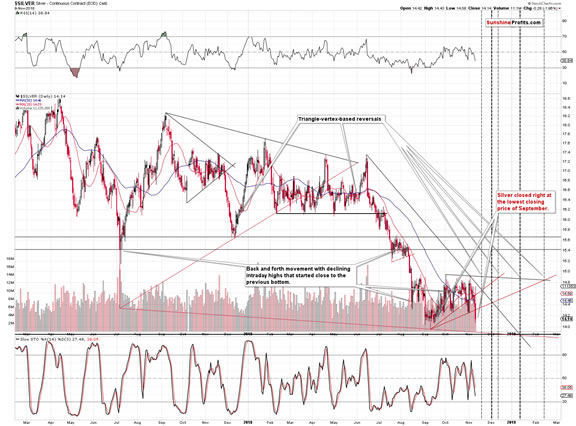
Silver’sdecline means breakdowns (on big volume) below the October lows and the risingred support line.
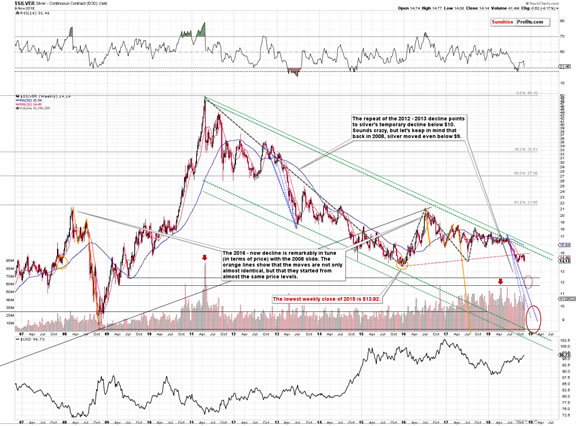
Fromthe long-term point of view, silver seems to have already completed thepost-breakdown correction and has now started its next move lower. The movesthat preceded the consolidation tend to be repeated after the consolidation iscompleted and this means that silver is soon likely to break below its 2015bottom.
Thiswill be a shocking event to those, who were calling the bottom in gold earlier this year.This shock might – and is quite likely to – turn into panic and sharp sellingas investors want to limit their losses. The support that is relatively farbelow the 2015 low and at the same time approximately corresponds to the sizeof the preceding decline is the area around the $12 level. That’s where we havetwo 2009 bottoms. None of them is extremely important, but they are the onlyones that we have between the 2015 bottom and the 2008 bottom, so they arequite likely to provide temporary support.
Anotherreason why Friday’s move is so important is the situation in the gold to silver ratio.
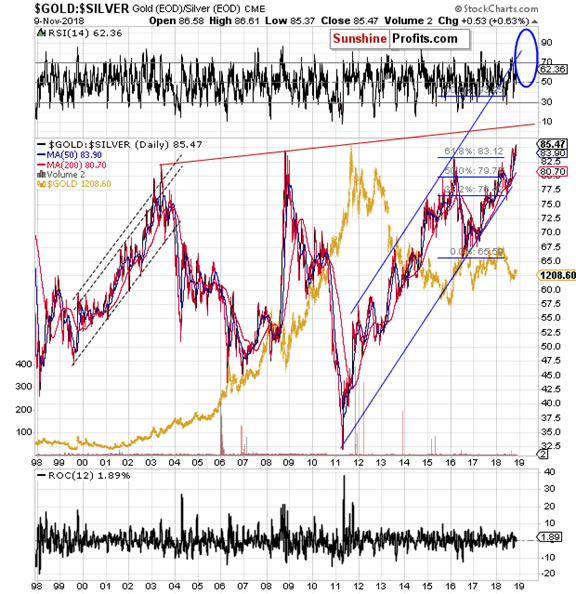
Witha weekly close above 85, it’s clear that the ratio broke above the previouslong-term highs. The next long-term target is the rising red line that’sapproximately at the 90 level and the final one is at about 100. Interestingly,with gold at about $1,050 and the ratio at 90, we get $11.67 as the silver price prediction, which is very closeto the April 2009 low (the lower one), which is $11.72. The above furthervalidates the interim price target area (around $12) for the white metal.
Thefull version of today’s analysis includes the details and forecasts for the gold market, and whilewe’ll keep them exclusive for our subscribers, we would like totell you about the critical signal that we saw in the gold stocks. It’s about somethingmuch more important than the short-term head-and-shoulders patterns.
GoldStocks’ Critical Indication
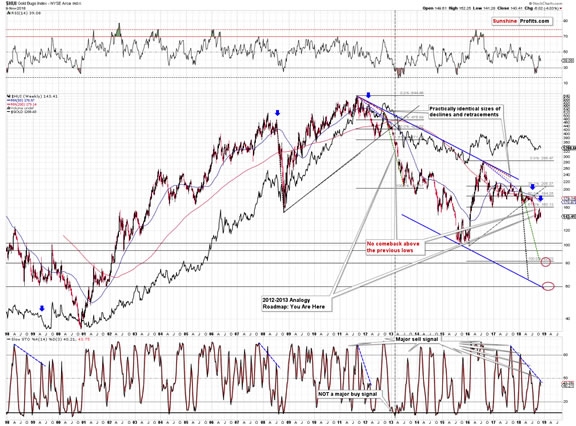
Namely,we just saw a sell signal from theweekly Stochastic indicator. This is a big deal, because this indicatorconfirmed major tops and preceded big price declines many times in the recentpast. The signal has been particularly useful since 2011.
Theother interesting thing is that we saw lower highs in the past several monthsand this is characteristic only for the biggest of the declines. We saw thiskind of performance of the weekly Stochastic indicator in 1999, in 2008, and in2012. The last two were obviously excellent times to exit the precious metalsmarket, but the first one appears to be different.
Andit was different, but not because of the regular factors. It was the Washington Agreement on Gold thatcaused gold to spike in 1999, taking the rest of the PM market with it. If itwasn’t for this spike, we would have likely seen a bottom in gold quite similarto what we saw in the gold stocks, and gold’s Brown bottom would have formedeven lower. The gold miners declined in a profound manner right after thespike. Consequently, if it wasn’t for the Washington Agreement, the preciousmetals sector would have most likely declined in a rather regular manner afterthe above-mentioned series of signals from the weekly Stochastic indicator.
Therefore,it seems justified to say that all 3 previous cases that are similar to what wesee right now, have been followed by the biggest declines of the past 20 years.The implications of this analogy and of the sell signal from the weeklyStochastic indicator are extremely bearish.
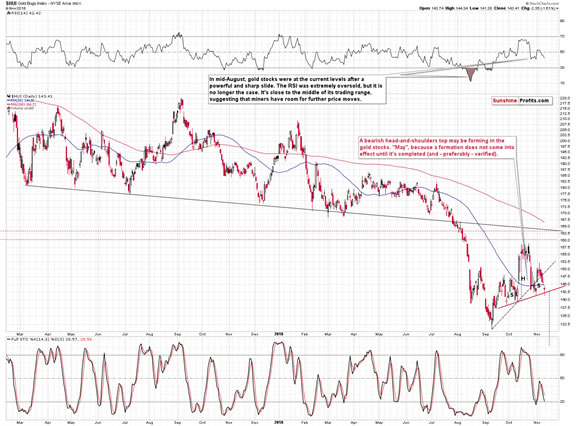
Fromthe short-term point of view, we see that the mining stocks moved visibly lowerbut that they haven’t completed the bearish head-and-shoulders formation justyet. Therefore, there are no implications of this formation just yet, but basedon the signals that we discussed previously today, it seems that the breakdownbelow the neck level is just around the corner and thus that the short-termoutlook will become very bearish shortly.
Tobe clear, it’s already bearish at this time and the latest confirmation of theoutlook comes from the confirmation of the breakdown below the rising dashedsupport line. The HUI Index moved visibly below it and closed below it forthree consecutive trading days.
Werecently wrote a lot about the incomplete inverse head-and-shoulders pattern ingold and we made some of those comments available publicly. But, to be honest,we don’t expect our analysis to change minds of either gold promoters or analysts that don’t payattention to details.
Visionvs. Facts
Inhis book Thinking, Fast and Slow, theNobel-prize laureate, Daniel Kahneman is explaining that when people have tochoose between the vision that they have for something that is based on (whatthey view as) coherent signals, and between obvious facts that contradict theirvision, they will choose the initial vision and ignore the facts. This effectis stronger if the vision is clearer and signals appear more coherent. A veryshort way to put it would be to say “my mind’s made up; don’t confuse me withfacts”.
Incase of the precious metals market, you have multiple sources that will want toconfirm the bullish outlook for gold simply because they can either sell theirgold and silver to you, or they can sell their analyses. The bias of the formerseems self-explanatory, but the latter requires an explanation.
They– the other analysts – know that, because we know that, and they have access tothe same statistics. The point is that onaverage, investors and traders don’t want to hear that something is goingto decline, especially if they have invested in it, or want to invest in it.This means that they will want to buy the analyses that are bullish, and theywill be reluctant to buy the analyses that dare to be bearish. And they willnot want to purchase anything that is bearish on average. We know that based onthe reactions to various types of analyses, ads, e-mail titles etc. we create.
Theabove means that analysts know that they are being rewarded for being bullishand are being punished for being bearish. What does that lead to? We reviewedthe free precious metals analyses that are available and almost all of them arebullish. And this is despite the huge number of bearish factors that we (alone)presented publicly in the previous weeks. This number exceeds the number ofbullish points that are generally being discussed (of course, one cannot countthe fundamental reasons as they do not determine market’s direction in theshort run and, in many cases, in the medium run). It’s important to note thatwe discuss the factors that appear bullish at the first sight, explaining andproving why they actually don’t make the outlook bullish, while the bullishcamp just ignores the bearish factors, pretending they are not there.
Investorsand analysts are being provided with facts and signals and they choose toignore them. Why? Because their bullish vision is too coherent for them to bewilling to accept that it may be incorrect.
Naturally,it would be easy to say the same about our analyses – why are we sticking tothe bearish outlook? Is it because of the above-mentioned bias? The differenceis that we don’t ignore the signals that are presented as bullish. Conversely,we welcome criticism and are happy to discuss the bullish factors. In fact, wewant to test our views against adverse indications. If our initial analysisfails to hold in light of new factors, it’s time to drop it, adjust the outlookand investment / trading positions accordingly, and prepare to benefit from themove that appears most likely based on the most up-to-date analysis.
Theobjectivity, care, and openness to change is what creates value for investors.Being biased is what destroys value, even if it is disguised as “stayingstrongly bullish during tough times”.
Andus? We’re taking the road much less travelled. The analysis needs to be done asobjectively as possible and investors’ real interest has to come first. That’swhy we will continue to describe things exactly as we see them, with as much objectivity as possible, utilizing diligenceand great care, even if it comes at our own expense.
Weadmit; that was a rather long digression. The reason that we mentioned theincomplete inverse head-and-shoulders in the first place was that we have anincomplete (!) head-and-shoulders in golds stocks. It doesn’t have anyimplications yet, but if completed, it will have a target below 130, meaning aclear break to new 2018 lows. The funny thing is that if one wants to viewincomplete H&S patterns as meaningful, then the bearish implications arecurrently even stronger.
Finally,let’s take a look at what happened in the USD Index.
USD’sBullish Outlook
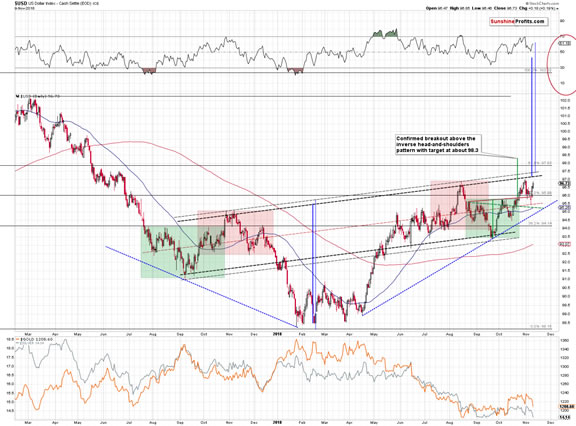
InFriday’s Gold Trading Alert, we wrote thefollowing:
The USD moved higher after a verybrief move back to the middle of its rising trading range that we marked with ared dashed line. It’s worth noting, because something similar happened in earlyAugust 2017 and since this year’s rally is the reflection of last year’sdecline, it could mean that this was the bottom and that higher values of theUSD Index will follow. The outlook for the medium term has been bullish for along time, but this time it finally seems that the multi-month consolidation isover. The implications are very bearish for the precious metals sector.
Theabove remains up-to-date, but we would like to add one more thing. On October 31st, we wrote that gold’s relativestrength to the USD Index is likely coming to an end and that this tendency islikely to be reversed. This is what is taking place right now. The USD Index isclose to its mid-August high and gold is not yet close to its mid-August low,but silver is already below its mid-August low. On the short-term basis, thecomeback is even clearer as its visible in both precious metals. The USD Indexis not yet above its late-October high, but both: gold and silver are belowtheir respective October lows. The implications are very bearish for theprecious metals sector, especially that the outlook for the USD Index isbullish.
Summary
Summingup, the outlook remains strongly bearish for the precious metals sector and thenew long-term and short-term sell signals confirm it.There is a hugeopportunity in taking advantage of the upcoming slide and then taking on bigpositions close to the final bottom, when others will be too scared to do so.Itseems that another big decline in gold, silver and mining stocks has just begunand that the huge profits on our short positions will become enormous shortly.
Naturally,the above is up-to-date at the moment of publishing it and the situation may –and is likely to – change in the future. If you’d like to receive follow-ups tothe above analysis (including the intraday ones, when things get hot), weinvite you subscribe to our Gold &Silver Trading Alerts today.
Thank you.
Przemyslaw Radomski, CFA
Founder, Editor-in-chief
Toolsfor Effective Gold & Silver Investments - SunshineProfits.com
Tools für EffektivesGold- und Silber-Investment - SunshineProfits.DE
* * * * *
About Sunshine Profits
SunshineProfits enables anyone to forecast market changes with a level of accuracy thatwas once only available to closed-door institutions. It provides free trialaccess to its best investment tools (including lists of best gold stocks and best silver stocks),proprietary gold & silver indicators, buy & sell signals, weekly newsletter, and more. Seeing is believing.
Disclaimer
All essays, research and information found aboverepresent analyses and opinions of Przemyslaw Radomski, CFA and SunshineProfits' associates only. As such, it may prove wrong and be a subject tochange without notice. Opinions and analyses were based on data available toauthors of respective essays at the time of writing. Although the informationprovided above is based on careful research and sources that are believed to beaccurate, Przemyslaw Radomski, CFA and his associates do not guarantee theaccuracy or thoroughness of the data or information reported. The opinionspublished above are neither an offer nor a recommendation to purchase or sell anysecurities. Mr. Radomski is not a Registered Securities Advisor. By readingPrzemyslaw Radomski's, CFA reports you fully agree that he will not be heldresponsible or liable for any decisions you make regarding any informationprovided in these reports. Investing, trading and speculation in any financialmarkets may involve high risk of loss. Przemyslaw Radomski, CFA, SunshineProfits' employees and affiliates as well as members of their families may havea short or long position in any securities, including those mentioned in any ofthe reports or essays, and may make additional purchases and/or sales of thosesecurities without notice.
Przemyslaw Radomski Archive |
© 2005-2018 http://www.MarketOracle.co.uk - The Market Oracle is a FREE Daily Financial Markets Analysis & Forecasting online publication.
